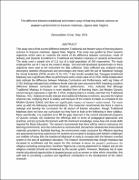| dc.description.abstract | This study was to find out the difference between Traditional and Modern ways of learning Islamic sciences in Kazaure madrasas, Jigawa State, Nigeria. This study was guided by three research objectives which were to: examine the extent of the difference between curriculum, mode of delivery and Students Enrollment in Traditional and Modern madrasas on students achievement. The study used a sample size of 112 out of a total population of 160 respondents. The study employed the use of T-test as the research design. Test and self-developed Questionnaire on three objectives were used as the instrument for data collection. Data collected was analyzed using descriptive statistics (frequencies and percentages and mean) with the aid of Statistical Package for Social Scientists (SPSS version 21.0). HO1: T-test results revealed that Tsangaya (traditional Madrasa) has a significant effect on performance with a mean value of 10.7035. While Independent tests indicate the difference between Madrasa Curriculum and Performance, with sig Value of 0.763, findings indicated that confidence levels intervals were assumed at 95% implying a positive difference between curriculum and Students performance. HO2: indicates that although Traditional Madrasa in Kazaure is more detailed form of learning Islam, but Modern Quranic school Kazaure represents a high M= 1.0743, implying that it is mostly used than the Traditional Madrasa. HO3: Statistical results indicate that traditional Madrasa enrolment, assumed the highest response rate, implying that it is widely used because of the content it entails as compared to the Modern Quranic School, and does not significantly impact on learner’s achievement. The study came up with the following recommendations: The researcher recommends that there is need to redesign and develop the curriculum for all sectors of Islamic education, though Traditional Madrasas does not have any curriculum but they have to look at the following in their syllabus. More specifically, it is expected (i) to fill the gaps observed in the current educational programs of Quranic schools, (ii) modernize the offerings both in terms of pedagogical approaches and practices, and (iv) provide the learners with the minimum knowledge, know-how and social skills required for Basic Education. The research recommends that there will be need to restructure the learning environment, once the curriculum is reconstructed, the teachers retrained and instructional materials provided to facilitate learning, the environment made conducive for effective teaching and appropriate learning experiences for students are provided in keeping with Modern challenges and realities of today then the traditional Madrasah is ready to compete with the Western oriented system in the area of qualitative education. The research recommends that, though madrasas had increased in enrollment and the reason for this increase is about the people’s preference for religious schooling among them, Northern Nigeria has a strong attachment to religion and yet the religious oriented schools are threatened by the secular system. However, Madrasas has to open market educational opportunities to targeted groups such as women or other ethnic minorities; this will help in providing a positive and significant contribution to the development of the nation character. | en_US |

